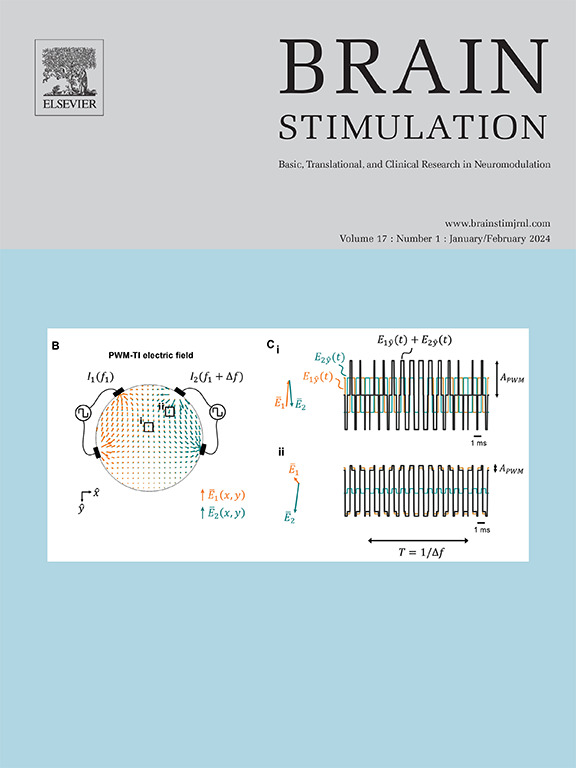Vagal nerve stimulation dynamically alters anxiety-like behavior in rats
IF 7.6
1区 医学
Q1 CLINICAL NEUROLOGY
引用次数: 0
Abstract
Background
Electrical vagal nerve stimulation (VNS), at currents designed to target sensory, interoceptive neurons, decreases anxiety-like behavior.
Objective/Hypothesis
We hypothesized that different VNS current intensities would differentially alter anxiety-like behavior through the activation of distinct brainstem circuits.
Methods
Electrodes were implanted to stimulate the left vagus nerve and to record diaphragm muscle and electrocardiogram activity. The VNS current required to elicit the A-fiber-mediated Hering-Breuer Reflex (HBR) was determined for each animal. Based on this threshold, animals received either sham stimulation or VNS at 1.5 (mid-intensity VNS) or 3 (higher-intensity VNS) times the threshold for HBR activation. Anxiety-like behavior was assessed using the elevated plus maze, open field test, and novelty-suppressed feeding test. Additionally, a place preference assay determined whether VNS is rewarding or aversive. Finally, a c-Fos assay was performed to evaluate VNS-driven neuronal activation within the brainstem.
Results
Mid-intensity VNS reduced anxiety-like behavior in the elevated plus maze and open field test. Higher-intensity VNS was aversive during the place preference assay, confounding anxiety measures. Both intensities increased overall c-Fos expression in neurons within the nucleus of the solitary tract, but mid-intensity VNS specifically increased c-Fos expression in noradrenergic neurons within the nucleus of the solitary tract while decreasing it in the locus coeruleus. In contrast, higher-intensity VNS had no effect on c-Fos expression in noradrenergic neurons of either the nucleus of the solitary tract or locus coeruleus.
Conclusion
Delivery of VNS induced reproducible, current intensity-dependent, effects on anxiety-like and aversive behavior in rats.
迷走神经刺激动态改变大鼠的焦虑样行为。
背景:迷走神经电刺激(VNS),在电流设计目标的感觉,内感受神经元,减少焦虑样行为。目的/假设:我们假设不同的VNS电流强度会通过激活不同的脑干回路而不同地改变焦虑样行为。方法:植入电极刺激左迷走神经,记录膈肌及心电图活动。测定每只动物诱发a -纤维介导的Hering-Breuer反射(HBR)所需的VNS电流。基于这个阈值,动物接受假刺激或1.5倍于HBR激活阈值(中强度VNS)或3倍于HBR激活阈值(高强度VNS)的VNS。焦虑样行为采用高架加迷宫、开阔场地测试和新奇性抑制进食测试进行评估。此外,一个位置偏好试验确定了VNS是有益的还是厌恶的。最后,进行c-Fos实验来评估脑干内vns驱动的神经元激活。结果:中强度VNS降低了高架加迷宫和空地试验的焦虑样行为。在位置偏好试验中,高强度的VNS是厌恶的,混淆了焦虑测量。两种强度均增加了孤立束核内神经元中c-Fos的总体表达,但中等强度VNS特异性增加了孤立束核内去肾上腺素能神经元中c-Fos的表达,而降低了蓝斑的表达。相比之下,高强度VNS对孤立束核和蓝斑核去肾上腺素能神经元中c-Fos的表达均无影响。结论:迷走神经刺激对大鼠焦虑样行为和厌恶行为的影响具有可重复性、电流强度依赖性。
本文章由计算机程序翻译,如有差异,请以英文原文为准。
求助全文
约1分钟内获得全文
求助全文
来源期刊

Brain Stimulation
医学-临床神经学
CiteScore
13.10
自引率
9.10%
发文量
256
审稿时长
72 days
期刊介绍:
Brain Stimulation publishes on the entire field of brain stimulation, including noninvasive and invasive techniques and technologies that alter brain function through the use of electrical, magnetic, radiowave, or focally targeted pharmacologic stimulation.
Brain Stimulation aims to be the premier journal for publication of original research in the field of neuromodulation. The journal includes: a) Original articles; b) Short Communications; c) Invited and original reviews; d) Technology and methodological perspectives (reviews of new devices, description of new methods, etc.); and e) Letters to the Editor. Special issues of the journal will be considered based on scientific merit.
 求助内容:
求助内容: 应助结果提醒方式:
应助结果提醒方式:


